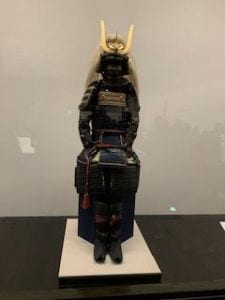
Established in 1993 the beautiful Edo-Tokyo Museum is the perfect place to be informed about Tokyo during the Edo period. There are many exhibits that are held throughout the year that helps tell the story of a city centuries ago. I absolutely love museums and this one reflects on the history and culture of Edo-Tokyo and envision the city and life of the future. Before walking into the museum, I noticed how lovely the architecture was of the building. It was different becuase we had to go up two sets of escalators to get to the front desk. I sort of reminded me of an elevated floor type warehouse. After checking in and showing our tickets we were greeted by an employee who was going to show us around the museum and explain the significance of the exhibit.
The photo below was explained to be Ashigaru, which is the type of armour that the soldiers wore during the Edo period. Their helmet was made out of metal and it was very common for the soldiers to shave their heads to due the accumulation of heat. I believe that the sleeves of the armour were made out of a lighter weighted kind of metal that resembled chainmail which made it easier for the soldiers to move around in when in combat.
One aspect of the museum was how they showed the lives of the Edo people. The daily lives of the people in Edo were exhibited by an array of annual events that took place every season in deep harmony with nature. The guide we had for this trip explained that the lifestyle of common people organized into three themes. The first theme is “the four seasons in Edo,” which introduces the transience of nature and annual events. The second theme is “entertainment areas in Edo” that integrated sacred and profane. The third and last theme is “journey and prayer” concerning the prayer journeys that common people made from Edo to holy sites, such as shrines and temples. The photo below is one I took of a shrine that is exhibited here at the museum. This shows the significance and importance of a Shinto Shrine. The red gate before a shrine is very common to see. The guide also explaied how the tan straw like cord hanging on the gate is used as a symbol of clouds and the sky as a whole. The white items hanging from that is a representation of lightning striking down onto the ground below.

